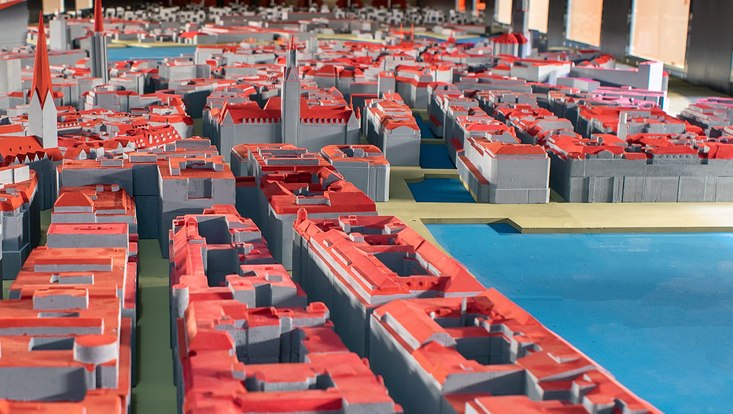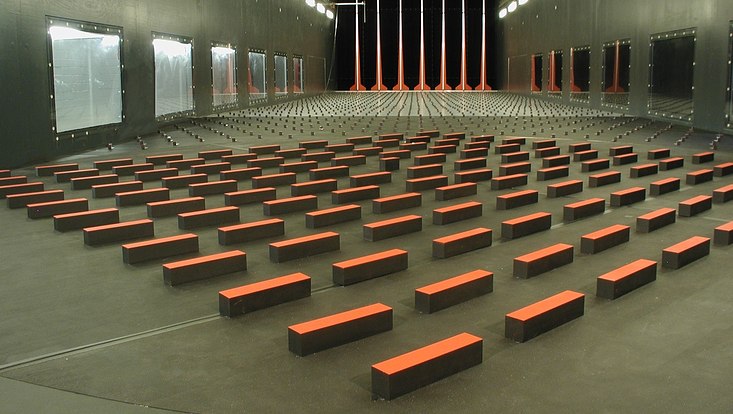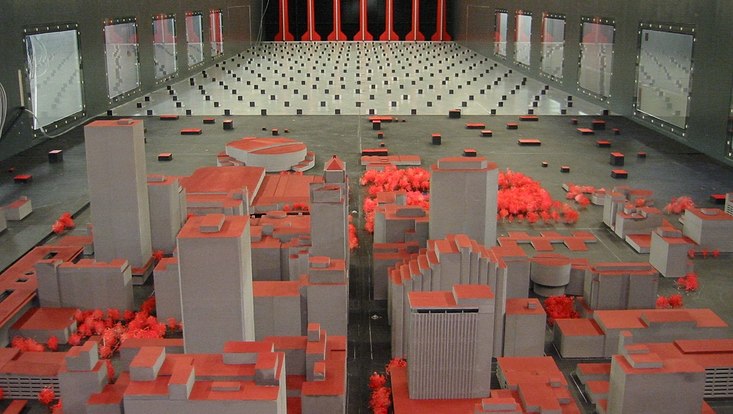data sets
The following data sets were generated at the Environmental Wind Tunnel Laboratory (EWTL) in Hamburg, Germany. All data is freely available. Anyone using the data, is requested to cite or reference this work. The measurement results within the data sets are zipped and password protected. Please contact ewtl.mi"AT"uni-hamburg.de to receive the password.
Heavy Gas Dispersion

Industrial chemical park UHH/EWTL
The heavy gas dispersion data set includes flow, neutral density and heavy gas dispersion measurements. Measurements have been performed in the WOTAN boundary layer wind tunnel of the Environmental Wind Tunnel Laboratory at the University of Hamburg. Three models of increasing complexity were used. The model with the highest complexity is a part of an industrial chemical park in the city of Ludwigshafen, which includes a multitude of different types of obstacles and buildings. The simplest setup is an area source with no obstacles in the model area, except for the surface roughness required for the ABL flow modelling.

Heavy gas release at an Idealized industrial park UHH/EWTL
A third model represents an idealized industrial park. Measurements have been performed with variations of the wind direction, source volume flow and wind speed. Detailed information regarding the data set are given in the readme file (so far in German language only). Additionally the data set is described in English language within a corresponding PhD thesis "Feasibility Study of Heavy Gas Dispersion Experiments in Complex Environments in Physical Modelling".
The measurements are part of the AIF project (IGF-Vorhaben Nr. 20719 BG) "Development of a software tool to simulate dispersion processes in an industrial environment".
Keywords: complex industrial chemical park, idealized industrial park, flow measurements, concentration measurements, heavy gas dispersion, neutral dispersion.
COST ES1006
The aim of the COST Action ES1006 is to evaluate and improve local-scale emergency prediction and response tools for airborne hazards in built environments. Within the scope of the Action two reference data sets including field and wind tunnel measurements were compiled.

Michelstadt UHH/EWTL
An extended "Michelstadt" wind tunnel experiment was designed as test case for the validation of local scale emergency response models. Michelstadt represents an idealized Central-European urban environment. Flow and concentration measurements were carried out in selected relevant locations with a higher density of data close to the ground. Measurements were collected for seven release scenarios corresponding to different point source locations and two different wind directions. Both continuous and short-term (puff) releases were carried out.
Keywords: idealized urban geometry, flow measurements, dispersion measurements, puff dispersion, flow statistics, time series.

CUTE UHH/EWTL
The CUTE (Complex Urban Test Experiment) data set includes results from field and wind tunnel measurements. The data set is dedicated to test ERT/ADM (Emergency Response Tools/Atmospheric Dispersion Models) predicting dispersion processes in urban areas. The test was done in the downtown area of a typical Central European city. The area of interest is densely built-up with building heights between 25 m and 35 m. There is no significant elevation and no major urban greenery in the modelled area. The first test scenario (CUTE case 1) of the CUTE dataset is a singular supplementary field experiment, carried out in a real European city center. Sulphur hexafluoride (SF6) was used as tracer and released continuously during the test for a period of 45 minutes with a constant flow rate of 2 g/s. Within the test area, the tracer was detected by 20 measurement devices.
The second part of the CUTE dataset (CUTE cases 2 to 4) consists of wind tunnel data measured in the model of the European city center, where the CUTE field test was carried out. The CUTE wind tunnel dataset consists of concentration data only. Concentration time series of tracer gas from continuous and puff releases were measured at pedestrian level.
Keywords: complex urban geometry, field measurements, wind tunnel measurements, dispersion measurements, puff dispersion, concentration statistics, time series.
For using the data set it is mandatory to sign the Data Policy Agreement of the COST Action ES1006. Please sent the signed copy to ewtl.mi"AT"uni-hamburg.de.
CEDVAL-LES
CEDVAL-LES is a compilation of wind tunnel datasets intended to be used for the validation of LES-based numerical flow and dispersion models. CEDVAL-LES contains reference data of flow and dispersion measurements. Wind tunnel models of different compexity were used for the measurements. The "COMPLEXITY 0" data set includes the documentation of three different boundary layers (moderatly rough, rough and very rough) in three different scales (1:500, 1:300 and 1:225). The COMPEXITY 1 case (flow around an isolated obstacle) is not included in the data set, yet.

Complexity 2 UHH/EWTL
In COMPLEXITY 2 flow and dispersion measurements were carried out within a regular array of obstacles. A configuration of cubes with flat and slanted roofs represnts a highly idealized urban geometry. A very rough boundary layer in the scale of 1:225 was generated in the large boundary layer WOTAN at the University of Hamburg. The data set includes results of flow and dispersion measurements (puff disperion).
Keywords: array of cubes, flow measurements, dispersion measurements, puff dispersion, flow statistics, time series, flat roof, slanted roof.

Michelstadt Complexity 3 UHH/EWTL
In COMPLEXITY 3 the level of detail of the urban geometry was further increased. An idealized model called Michelstadt in the scale of 1:225 was mounted in the wind tunnel WOTAN. The model represents typicall geometries of residential areas in central European cities. The data set includes time series of flow measurements taken at horizontal planes, vertical profiles and measurement position within the street canyons. Two different Michelstadt models were used. In Michelstadt 1 all buildings have a flat roof, while in Michelstadt 2 all buildings in the central part of the model have a slanted roof.
Keywords: idealized urban geometry, flow measurements, time series, flow statistics, flat roof, slanted roof.
COST 732
The main objective of the COST action is to improve and assure the quality of micro-scale meteorological models that are applied for predicting flow and transport processes in urban or industrial environments. Within the scope of the Action COST 732, two reference data sets were compiled.

MUST UHH/EWTL
The first dataset called MUST contains flow and dispersion data measured within an idealized urban roughness. The experimental setup originates from the "Mock Urban Setting Test - MUST", an extensive field test carried out on a test site of the US Army in the Great Basin Desert in 2001.
Keywords: idealized urban geometry, flow measurements, dispersion measurements, flow statistics.

Oklahoma UHH/EWTL
The second data set called Oklahoma contains flow anddispersion data measured in a model of the downtown area of Oklahoma City. The experimental setup originates from the Joint Urban 2003 Oklahoma City Atmospheric Dispersion Study.
Keywords: complex urban geometry, flow measurements, dispersion measurements, flow statistics, concentration statistics.
CEDVAL
CEDVAL is a compilation of mainly wind tunnel datasets that can be used for validation of numerical dispersion models. The primary goal of CEDVAL is to provide validation data at a higher level of quality than most of the data available can provide so far. All data sets within CEDVAL follow a high quality standard in terms of complete documentation of boundary conditions and quality assurance during measurements. The database will be extended step by step by more complex configurations.
Keywords: models of different compexity, isolated obstacles, array of obstacles, flow measurements, dispersion measurements, flow statistics concentration statistics.

